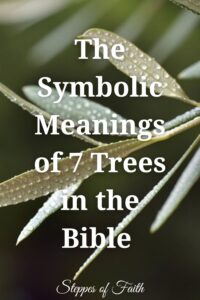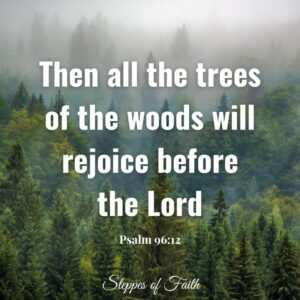
“Then all the trees of the woods will rejoice before the Lord.” (Psalm 96:12)
Did you know both the Old and New Testaments mention 36 different types of trees? The mention of these tree species is no accident. Here, we examine seven of the more significant tree types, where you can find them in the Bible, and how they fit into God’s narrative.
The Broom Tree
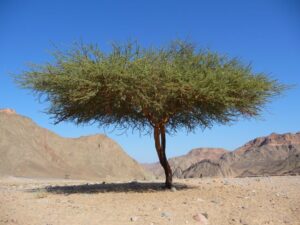
“But he himself went a day’s journey into the wilderness and came and sat down under a broom tree.” (1 Kings 19:4)
Broom trees are mentioned several times in the Old Testament. Most Bible translations call it a “broom tree.” Others call it a “broom bush.” The KJV and NASB translations call it “juniper,” but it is all the same flowering desert plant.
The broom tree can grow up to eight feet tall, making it an excellent source of shade from the hot Middle Eastern sun. This is why the Bible usually associates broom trees with shelter and rest.
In 1 Kings 19:1-9, we read about the prophet Elijah running from the evil Queen Jezebel and finding rest under a broom tree. As he slept, an angel of the Lord came to him and provided food and water to strengthen him for his journey to Mount Horeb to meet Elisha.
Numbers 33:18-19 mentions a village called Rithmah, which is the Hebrew word for “place of the brooms.” Rithmah was one of the rest stops the Israelites passed through on their way to the Promised Land.
In addition to rest, Psalm 120:4 compares a broom tree to God’s judgment “with coals of the broom tree.” And Job mentions it as a desperate food source for those who have turned away from him (Job 30:4).
Primarily, the broom tree reminds us of God’s provision and shelter. No matter our circumstances, even when all seems hopeless, He offers us protection and rest.
Cedar of Lebanon
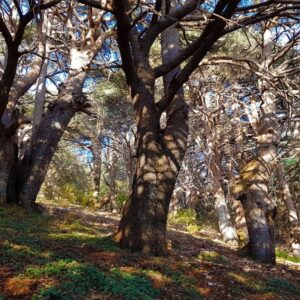
“The righteous shall flourish like a palm tree. He shall grow like a cedar in Lebanon.” (Psalm 92:12)
The Old Testament mentions the cedar of Lebanon tree many times. A cedar can grow to over 100 feet tall and live for well over 100 years.
Cedars are named for their location in the mountains of Lebanon. The wealthy often used them in construction due to their beautiful red color, sweet aroma, and strength, which is why cedar trees are usually associated with prestige and power. For example, King Hiram of Tyre used cedar trees as the primary material in the construction of both King David’s and Solomon’s palaces (2 Samuel 5:11; 1 Kings 5:6-18; 7:1-7; Ezra 3:7). King Jehoahaz (sometimes called Shallum) also used cedar in his palace.
In Ezekiel 32:10-17, God compared Egypt to a mighty cedar tree that He will tear down. And Psalm 29:5 and 92:12 mention a cedar’s strength. Several verses compare a cedar to God’s judgment because of a nation’s pride and arrogance. See Isaiah 2:13, Amos 2:9, and Zechariah 11:1-2.
In other passages, the maiden compares her lover’s countenance to a cedar tree in Song of Solomon 5:15. And Job compares it to a behemoth’s tail in Job 40:17, which many scholars interpret as one of the few biblical references to a dinosaur.
A cedar tree has great strength, but God’s strength is greater, ensuring we can experience His strength in our weaknesses (2 Corinthians 12:9).
Acacia Trees
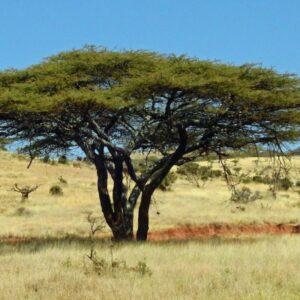
“And they shall make an ark of acacia wood. And you shall make poles of acacia wood, overlay them with gold.” (Exodus 25:10,13)
Acacia is a general term describing five types of thornwood shrubs and trees people have harvested for centuries. The King James Version alternately calls it “shittah (Isaiah 41:19)” and “shittim (Exodus 25:5)” and are the only hardwood trees that grow in arid areas. As such, God often used acacia as His chosen building material.
In addition to creating the ark of the covenant and poles to carry it through the wilderness (Exodus 25:10-16), God instructed Moses to use acacia to build the showbread table (25:23-28) and the altar of burnt offering (27:1).
The prophet Isaiah also mentions the acacia tree in Isaiah 41:19, describing the rich vegetation that will fill the land when God redeems the Jewish people.
“I will plant in the wilderness the cedar and the acacia tree, the myrtle, and the oil tree. I will set in the desert the cypress tree and the pine and the box tree together.”
The acacia tree reminds us of God’s steadfastness and truth in keeping His promises.
Tamarisk/Salt Cedar Trees
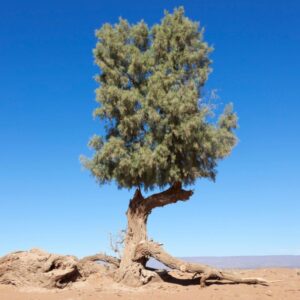
“Then Abraham planted a tamarisk tree in Beersheba, and there called on the name of the LORD, the Everlasting God.” (Genesis 21:33)
The tamarisk tree is another robust and slow-growing tree that lives well over 100 years old. It has the unusual ability to thrive in places where the soil is too salty to support most plant life. One such place is southern Israel, where a tamarisk tree exudes salt on its leaves to absorb moisture from the air. For this reason, a tamarisk tree is also known as salt cedar.
The mention of a tamarisk tree reveals Abraham’s location in Genesis 21:22-34, where Abraham had just formed a treaty with Abimelech, the king of Schechem. The treaty established friendly relations and Abraham’s rights to a specific well. The tamarisk tree was a celebration of the treaty as well as a marker of a site where Abraham worshiped and called the Lord “El Olem,” which means “Everlasting God (v33).”
Tamarisks do not offer much shade but create a cooling microclimate as moisture evaporates off the leaves. Such natural air conditioning is likely why King Saul took refuge under it in 1 Samuel 22:6 as he pursued David.
Tamarisks remind us of God’s faithfulness, strength, and provision in difficult situations. As an evergreen tree, one could also argue that tamarisks represent eternal life and God’s eternal nature (“El Olem”).
Sycamore Trees
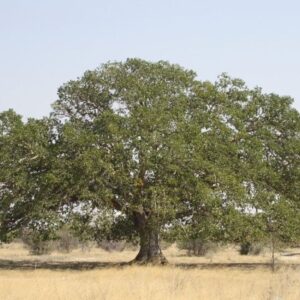
“So, he ran ahead and climbed up into a sycamore tree to see Him, for He was going to pass that way.” (Luke 19:4)
Unlike other sycamore trees, the sycamore tree of the Bible, made famous by Zacchaeus in Luke 19, is not a sycamore at all. It is a type of fig tree with leaves like a mulberry tree, which is why it is sometimes called a fig-mulberry. Today, there are few sycamores left in the Middle East. But in biblical times, they were a widespread agricultural product grown along the coastal plains and foothills (1 Kings 10:27; 2 Chronicles 1:15).
Most of the sycamore tree was edible, from its small fruit to its bark. As the prophet Amos mentions, sheep farmers often hired shepherds to encourage the trees’ ripening by piercing their bark.
“Then Amos answered and said to Amaziah: ‘I was no prophet, nor was I a son of a prophet [previously]. But I was a sheepbreeder and a tender of sycamore fruit.’” (Amos 7:14, with addition)
According to the prophet Isaiah, many homebuilders used sycamore trees to build a home’s roof rafters.
“The bricks have fallen, but we will rebuild with hewn stones. The sycamore trees are cut down, but we will replace them with cedars.” (Isaiah 9:10)
Sycamores are often associated with repentance, which means finding Zacchaeus in a sycamore tree in Luke 19 is no accident. In Hebrew, Zacchaeus means “righteous one” or “pure.” The irony is that he was a tax collector who was neither righteous nor pure. But when he encountered Jesus, he repented and began showing spiritual fruit (19:8) with his righteousness restored.
The wordplay connections between a sycamore tree and Zacchaeus suggest sycamore trees symbolize repentance, righteousness, and (as a fig tree) spiritual fruitfulness.
Fig Trees
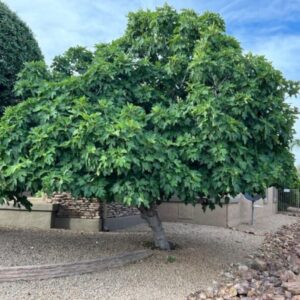
“Jesus answered and said to him, ‘Because I said to you, ‘I saw you under the fig tree,’ do you believe?’” (John 1:50)
The fig tree is a highly prosperous tree throughout Israel. It is so prolific that there are sixty different Greek words related to fig, fig tree, and fig agriculture.
Unlike the sometimes-bitter fig-mulberry/sycamore tree fruit, the ficus carica produces larger and sweeter fruit. More notably, it produces fruit before it sprouts its large leaves in early spring (an important fact to remember when reading Matthew 21). The tree may continue producing multiple sets of leaves and fruit until the fall.
The Bible contains numerous references to fig trees.
- Adam and Eve sewed fig leaves together after the fall to hide their nakedness (Genesis 3:7).
- God declared judgment on Israel (Hosea 9:10).
- The prophets encouraged Israel in God’s faithfulness (Joel 2:22, Micah 4:4; Zechariah 3:10)
- Jesus found His disciple Nathaniel sitting under a fig tree (John 1:50).
- Zacchaeus climbed a fig tree (“sycamore”) to get a better view of Jesus (Luke 19:4).
- Jesus told two parables based on fig trees (Luke 13:6-9; 21:29-33).
- Jesus cursed a fig tree on a trip to Jerusalem (Matthew 21:18-22).
Bible prophecy also mentions fig trees: judgment of the nations (Isaiah 34:4), Jewish profession of faith in the Messiah Jesus (Habakkuk 3:17), and the opening of the sixth seal during the Tribulation (Revelation 6:13).
Fig (and sycamore) trees always symbolize spiritual fruitfulness, peace, prosperity, and Israel’s well-being.
More Than Fruit
At one time, there was a common Jewish expression that if one sat under their vine and fig tree, one enjoyed peace and prosperity. The expression is taken from several portions of the Old Testament.
First Kings 4 describes the early days of King Solomon’s thriving reign over Judah and Israel. It was a time of “eating, drinking, and rejoicing (v20).” His enemies were at peace, so the people “dwelt safely, each man under his vine and his fig tree (v25).”
Both the prophets Micah (4:4) and Zechariah (3:10) spoke of the coming Millenium, when God finally establishes peace over the entire earth. At that time, everyone will again sit under his own “vine and fig tree.”
The Old Testament uses figs to describe Israel’s physical and spiritual well-being. In good times, the people are “the firstfruits on the fig tree in its first season (Hosea 9:10).” But in times of judgment, the people bear no fruit (see Joel 2:22; Habakkuk 3:17-19; Haggai 2:19).
In the New Testament, Jesus uses fig trees to represent Israel’s lack of fruitfulness (Mark 11:12-14) and as a metaphoric warning system for the time of His return (Matthew 24:32; Luke 13:3-9).
Fig trees illustrate not only Israel’s spiritual health but also God’s goodness, provision, judgment, and faithfulness.
Olive Trees
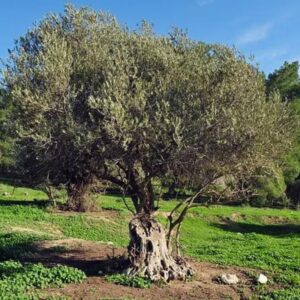
“Your wife shall be like a fruitful vine in the very heart of your house, your children like olive plants all around your table.” (Psalm 128:3)
Like figs, olives are historically prevalent throughout Israel and an important agricultural commodity. An evergreen tree, olive trees can grow more than twenty feet tall and live about 500 years, producing olives from late spring to early fall.
The Bible mentions olive trees frequently from Genesis to Revelation, making it perhaps the most famous tree in the Bible. It first appears when a dove returns to Noah with an olive leaf after the great flood (Genesis 8:11) and last appears as the two witnesses representing Israel’s spiritual revival in the last days (Revelation 11:1-11).
The Bible typically uses olives to symbolize peace, spiritual renewal, blessing, anointing, and abundance. They also symbolize Israel.
In Jeremiah 11:16-17, God reminds His people of His covenant with them, where the olive tree is Israel, and God is the farmer. Jesus repeats this analogy in Luke 13:6-9, using figs instead of olives.
Romans 11:24 compares Gentiles to a wild olive tree God has grafted into the nurtured olive tree (Israel). As a result, the wild olive tree can also bear fruit.
Olives also symbolize Jesus. Just as olives are crushed to extract their oil, Jesus was crushed for our sins on the cross, and His Spirit (the oil) is applied to our hearts when we come to faith in Him. Such an analogy is likely why Jesus prayed in Gethsemane (meaning “oil press”) on the night of His arrest.
Olive trees are another symbol of God’s eternal goodness, faithfulness, peace, and newness of life. They also remind us of the torture Jesus endured and His atoning sacrifice for our sins on the cross.
Of course, there are many other trees in the Bible: grape, pomegranate, oak, date, almond, gopher, and cypress, not to mention the Tree of the Knowledge of Good and Evil and the Tree of Life. Understanding their unique meanings enriches how we study the Bible, the depth of God’s love, and the lessons we should learn as we look for the day of His return.
